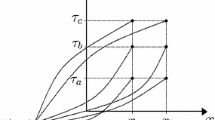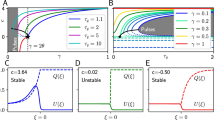Abstract
The dynamics of directionally tuned linear multi-input single-output systems varies generally as a function of the spatial orientation of the inputs. A linear system receiving directionally specific inputs is represented by a linear combination of the respective input transfer functions. The input-output behaviour of such systems can be described by a vector transfer function which specifies the polarization directions of the system in real space. These directions, which can be either one (unidirectional vector transfer function) or two (bidirectional vector transfer function) but never three, are obtained by computing the eigenvectors and eigenvalues of the system matrix that is defined by the gain and phase values of the system's response to harmonic stimulation directed along three orthogonal directions in space. The spatial tuning behaviour is determined by the quadratic form associated with the system matrix. Neuronal systems with bidirectional vector transfer functions process input information in a plane-specific way and exhibit novel characteristics, very much different from those of systems with unidirectional vector transfer functions.
Similar content being viewed by others
References
Angelaki DE (1991) Dynamic polarization vector of spatially tuned neurons. IEEE Trans Biomed Eng 83:1053–1060
Angelaki DE (1992) Two-dimensional coding of linear acceleration and the angular velocity sensitivity of the otolith system. Biol Cybern 67:511–521
Angelaki DE (1993) Spatial and temporal coding in single neurons. Biol Cybern 69:147–154
Angelaki DE, Bush GA, Perachio AA (1992) A model for the characterization of the spatial tuning properties in vestibular neurons. Biol Cybern 66:231–240
Angelaki DE, Bush GA, Perachio AA (1993) Two-dimensional spatiotemporal coding of linear acceleration in vestibular nuclei neurons. J Neurosci 13:1403–1417
Baker J, Goldberg J, Hermann G, Peterson B (1984) Spatial and temporal response properties of secondary neurons that receive convergent input in vestibular nuclei of alert cats. Brain Res 294:138–143
Baker J, Goldberg J, Peterson B (1985) Spatial and temporal response properties of the vestibulocollic reflex in decerebrate cats. J Neurophysiol 54:735–756
Blanks RHI, Estes MS, Markham CH (1975) Physiological characteristics of vestibular first order canal neurons in the cat. II. Response characteristics to constant angular acceleration. J. Neurophysiol 38:1250–1268
Born M, Wolf E (1980) Principles of Optics. Pergamon Press, Oxford
Bush GA, Perachio AA, Angelaki DE (1993) Encoding of head acceleration in vestibular neurons: spatiotemporal response properties to linear accelerations. J Neurophysiol 69:2039–2055
Fernández C, Goldberg JM (1976) Physiology of peripheral neurons innervating otolith organs of the squirrel monkey. I. Response to static tilts and to long-duration centrifugal force. J Neurophysiol 39:970–984
Hess BJM (1992) Three-dimensional head angular velocity detection from otolith afferent signals. Biol Cybern 67:323–333
Loe PR, Tomko DL, Werner G (1973) The neural signal of angular head position in primary afferent vestibular nerve axons. J Physiol (Lond) 230:29–50
Author information
Authors and Affiliations
Rights and permissions
About this article
Cite this article
Hess, B.J.M., Angelaki, D.E. Modelling spatiotemporal properties of directionally sensitive multi-input single-output systems. Biol. Cybern. 69, 407–414 (1993). https://doi.org/10.1007/BF01185412
Received:
Accepted:
Issue Date:
DOI: https://doi.org/10.1007/BF01185412




